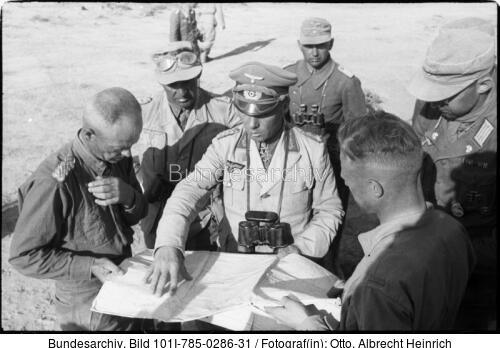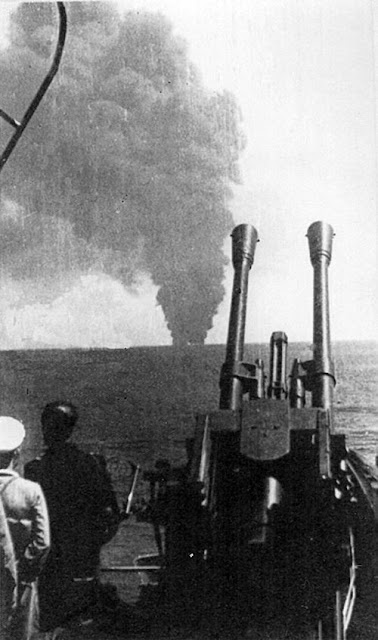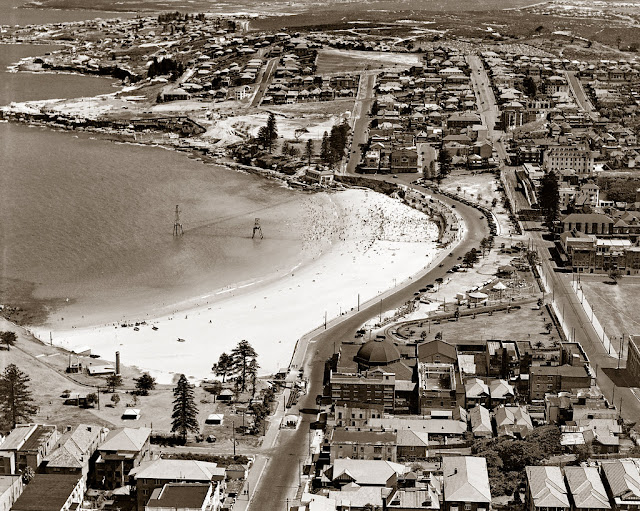Monday 15 June 1942
 |
| Royal Navy Tribal-class destroyer HMS Bedouin sinking during Operation Harpoon, 15 June 1942 (Ministero Della Difesa-Aeronautica, Regia Aeronautica). |
Battle of the Mediterranean: The Italian military gets a lot of grief from post-war armchair generals, but the navy proves it can fight and inflict heavy damage on 15 June 1942. This becomes known as the Battle of Pantelleria and merits a later visit (25 June) by Mussolino to congratulate the crews. Of course, the Battle of Pantelleria (In Italy, "Battaglia di Mezzo Giugno") is not played up in Allied post-war histories, rarely mentioned except occasionally as just another convoy battle.
The disaster that is Operation Julius, a conventional British resupply of Malta from both ends of the Mediterranean simultaneously, continues with more Allied losses. The situation has become so chaotic and untenable that the eastern half of the operation, Operation Harpoon, is temporarily called off, but then the order is reversed due to the "fog of war" - overly optimistic reports from Allied aircrews sent to attack the Italian fleet.
It is a day of repeated Axis air attacks, many near misses and bombers shot down, and lost opportunities. After dark, Admiral Harwood finally cancels Operation Vigorous. Most of the ships are lost due to mines and the Italian surface fleet - two of the original six freighters make it to Malta despite the cancellation, delivering 15,241 tons of supplies. The failure of the tanker Kentucky to make port causes a fuel crisis on the island.
Italian Regia Aeronautica aircraft, which have been particularly effective during these attacks, bomb and severely damage Australian destroyer Nestor off Crete. It survives until the 16th, when it must be scuttled.
German E-boat S-56 (some sources say S-66) torpedoes Royal Navy light cruiser HMS Newcastle, severely damaging it. Newcastle does not become operational again until March 1943. British destroyer Hasty, damaged in the same way by E-boat S-55 before dawn, must be scuttled off Crete.
The Italian surface fleet also gets into the act. At dawn, Italian cruisers aided by the Regia Aeronautica hit the British off Pantelleria south of Sicily. Air attacks disable British tanker Kentucky (9457 tons) and freighters Chant, Bedouin, and Burdwan - all eventually sink due to naval gunfire or torpedoes.
The British are able to strike back, though the weight of arms is heavily against them. Four Wellingtons out of Malta attack the Italian ships and score a torpedo hit on the cruiser Trento. Royal Navy submarines Maydon and Ultimatum spot battleship Vittorio Veneto and attempt attacks, but with no success due to the effective screen of cruisers. Submarine Umbra later finds Trento, dead in the water, and sinks it with two torpedoes.
 |
| Damage to battleship Littorio from a 500-lb bomb hit by a USAAF B-24. The bomb apparently hit Turret No. 1, killing one man and injuring 12 but causing only superficial damage to the turret. |
The Italian fleet, less Trento, continues south and is attacked by B-24 bombers, with battleship Littorio taking a hit from a 500-lb bomb and, much later, a torpedo hit that causes little damage. A later RAF attack and a dogfight ensues, the Luftwaffe shooting down two Beauforts and badly damaging five others (one crashes).
Ships Lost:
- Trento (Italian cruiser) - 570 dead, 581 survivors.
- HMS Airedale (destroyer) - 45 dead, 133 survivors
- HMS Bedouin (destroyer) - 28 dead, 213 survivors
- HMAS Nestor (destroyer) - four dead, scuttled 16 June.
- Burdwan (6,069-ton British freighter)
- Chant (5601-ton U.S. freighter) - four dead, 81 survivors.
- Kentucky (9308-ton British tanker) - damaged by Stukas, finished off by Italian surface fleet.
- Burdwan (6069-ton British freighter) - damaged by Stukas, finished off by Italian surface ships.
- HMS Newcastle (Town-class cruiser) - torpedoed and damage by S 56, towed to port and returned to service in March 1943.
- Italian 215-ton minesweeper RD 7 - hits a mine and sinks off Saronikus, Greece.
On land, the situation is even worse for the British. Their struggling forces are pushed out of Knightsbridge, the Point 650 box lost, and General Erwin Rommel's 21st Panzer Division reaches Sidi Rezegh. The 15th Panzer Division cuts the road east of Tobruk, but the South African Division escapes before then. The struggling British Eighth Army does get some relief because the Luftwaffe is occupied with the convoys out at sea. This is one of the darkest days of the Mediterranean campaign for the British, with the certainty of more bad days to follow as they draw back on Tobruk.
The Fuhrer's staff apparently is pleased, and in any event he is still at the Berghof, so it is a good day at headquarters in East Prussia. General Franz Halder notes in the war diary that "Army Corps 'Africa' has broken through to the coast west of Toburk. Cheering success!
 |
| Colonel-General Erwin Rommel with Major-General Georg von Bismarck, commander of the 21st Panzer Division, ca. 15 June 1942 (Otto, Albrecht Heinrich, Federal Archive Picture 101I-785-0286-31). |
Eastern Front: General Manstein's attack toward Sevastopol continues making good progress, especially in the north. The Soviets are still fighting hard, though, and have plenty of ammunition remaining. Heavy operations continue on land, air, and sea, where an Italian mini-submarine has an unusual success when it torpedoes and sinks a surfaced Soviet submarine sailing off Cape Sarych. at Fuhrer Headquarters, General Franz Halder notes blandly in his war diary, "Advancing in southern and northern sector Sevastopol, and at Volchansk."
The German 132nd Division is leading the main attack in the north and now is within 900 meters of the Maxim Gorky fortress perimeter. The Soviet defenders of the 95th Rifle Division and 7th Naval Brigade are down to just 1000 men - basically, a single regiment. However, the Wehrmacht also has taken a staggering number of casualties just to get this far.
In the south, the Germans are stopped before Balaklava and the Soviets still hold the critical Sapun Ridge. Somewhat dismaying for the Germans is that they have captured only about 1000 Soviet soldiers but a staggering 1500 mortar projectiles, suggesting the defenders have plenty of ammunition while they themselves are always short.
The Luftwaffe, though, is making up for the German deficiencies on the ground. It has been averaging about 780 sorties a day since the start of the offensive with virtually no let-up. Attacks on Sevastopol cause first that can be seen in Feodosiya, 150 km away. From 13-17 June, the planes drop 3,086 tons of bombs.
Luftwaffe General Wolfram von Richtofen, a chief architect of the brewing German success at Sevastopol (and who rightfully deserves as much credit as Manstein), gets news that disgusts him. Reichsmarschall Goering phones him - usually quite an honor - and informs him that he is to be transferred north to Kursk to prepare for Case Blue - the summer attack toward Stalingrad. He will retain control of Fliegerkorps VIII, but his chief of staff, Oberstleutnant Torsten Christ, will remain behind and guide operations henceforth.
Battle of the Baltic: Soviet submarine M-95 hits a mine east of Suursaari Island around this date, when she is declared missing. All hands are lost, the wreck is discovered in 2015. Also lost on this date is Soviet G-5-class motor torpedo boat No. 61.
 |
| The crew of Italian cruiser Raimondo Montecuccoli watches tanker Kentucky and freighter Burdwan burn, 15 June 1942 (Regia Marina). |
Battle of the Pacific: Following the decisive victory at Midway, the Americans are reorganizing and making new plans. Admiral Nimitz reorganizes his carrier force, making Admiral Fitch temporarily commander of Task Force 11 in place of Admiral Fletcher, who takes a badly needed break for a couple of weeks. The first plan for Task Force 11 is to resupply Midway with aircraft. Later it is to head to the Southwest Pacific in July.
In the Aleutian Islands, bad weather aborts a bombing mission to Kiska Island by 3 B-17 and 2 B-24 bombers of the 11th Air Force.
US Navy submarine USS Seawolf torpedoes and sinks Japanese auxiliary gunboat Nampo Maru off Corregidor.
European Air Operations: Major General Carl Spaatz, new Commanding General of the USAAF's 8th Air Force, arrives to take up his command in the UK. The VIII Bomber Command establishes the 1st Bombardment Wing (Provisional) at Brampton Grange, England.
 |
| U-751 commander Gerhard Bigalk at St. Nazaire, 15 June 1942. He has just this day returned from U-751's sixth war patrol, during which it has sunk two American ships totaling 4555 tons of shipping (Federal Archive Bild 101II-MW-6433-39). |
Battle of the Atlantic: U-172 (Kptlt. Carl Emmermann), on its second patrol out of Lorient, torpedoes and sinks 2438-ton Norwegian freighter Bennestvet in the Caribbean. There are 12 dead and 13 survivors, who are rescued by USS PC-458.
U-552 (Kptlt. Erich Topp), on its ninth patrol out of St. Nazaire, has a big day against a British convoy, with five ships sunk. This is one of the top totals of the war. He sinks 15,858 tons of shipping in one day in one convoy not too far from his base and then quickly heads back to port to stock up again on torpedoes.
First, it torpedoes and sinks 2759-ton British freighter City of Oxford west of Cape Finisterre, Spain. It is part of convoy HG 84. There are one death and 42 survivors, who are picked up by freighter Stockport.
U-552 gets another one in the same convoy in the same general vicinity west of A Coruña, Spain. This victim is 1943-ton British freighter Etrib. There are four deaths and 41 survivors, who are rescued by HMS Marigold.
U-552's third victim in the convoy is 1346-ton British freighter Pelayo. There are 17 deaths and 30 survivors, rescued by freighter Copeland.
U-552's fourth ship is the 2436-ton British freighter Thurso. There are 13 deaths and 28 survivors, rescued by HMS Marigold.
U-552 also gets a fifth victim, Royal Navy 7374-ton tanker Slemdal, also 400 nautical miles northwest of A Coruña. All 37 crew survive. It is unconfirmed whether this was by U-552.
 |
| Italian destroyers watch Allied ships burn, 15 June 1942. Photo taken from destroyer Oriani, with Ascari and Oriani ahead. |
U-502 (Kptlt. Jürgen von Rosenstiel), on its fourth patrol out of Lorient, also has a big day. It sinks three ships to end its patrol with 54,045 tons of shipping sunk.
First, it torpedoes and sinks 5010-ton Panamanian freighter Cold Harbor 100 nautical miles (190 km) northwest of Trinidad. There are seven deaths and 44 survivors, who are rescued by U.S. ships Exmouth and Kahlua and U.S.S. Opal.
U-502 also torpedoes and sinks 8001-ton U.S. freighter Scottsburg 90 nautical miles (170 km) west of Grenada. There are five dead and 46 survivors, rescued by U.S. ship Kahuku.
U-502 also torpedoes and sinks 5702-ton U.S. Freighter West Hardaway 30 nautical miles (56 km) west of Grenada. All 50 crew are rescued by Venezuelan ship Maracaibo.
U-68 (KrvKpt. Karl-Friedrich Merten), on its fourth patrol out of Lorient, torpedoes and sinks 9242-ton Vichy French tanker Frimaire northeast of Santa Maria, Columbia. All 60 crewmen perish.
U-126 (Kptlt. Ernst Bauer), on its fourth patrol out of Lorient, shells and sinks 125-ton British sailing freighter Dutch Princess east of St. Lucia and northwest of Barbados. All nine crewmen survive.
In the South Atlantic off the coast of Brazil, Italian submarine Archimede torpedoes and sinks 5586-ton Panamanian freighter Cardinia.
U-701 (Kptlt. Horst Degen), on its third patrol out of Lorient, recently has laid mines at the entrance to Chesapeake Bay, and today they pay off dramatically with multiple hits.
Royal Naval trawler HMT-Kingston Ceylonite hits a mine and sinks in the Chesapeake Bay off Virginia Beach, Virginia while with Convoy KN 109. There are 18 deaths and 14 survivors. U.S. 11,615-ton tanker Robert C. Tuttle also hits a mine in the same vicinity and sinks, with one dead and 46 survivors. Tuttle, however, is later raised, repaired, and returned to service.
U.S. 9310-ton tanker F.W. Abrams sinks after hitting a U.S. mine off Cape Hatteras, North Carolina, on 11 June. The tanker had been hiding in the minefield for safety when it blundered into one in heavy rain, then drifted into a second one. Attempts to salvage have failed, and it finally sinks today about 20 km off Ocracoke. Every one of the 36-man crew survives, with one injured.
Royal Navy motor torpedo boat (MTB) 201 is badly damaged by German surface warships off Dover and sinks while under tow.
 |
| U.S. tanker F.W. Abrams sinking off Cape Hatteras, 15 June 1942 (The Mariner's Museum). |
Spy Stuff: The leader of the German spy ring that is staying at a Manhattan hotel, George Dasch, has called the New York office of the FBI and told them about his operation in an effort to surrender. Displeased at the result, however, he sits and brews, waiting until the weekend to take a train down to Washington, D.C., to surrender.
U.S. Military: 63d Bombardment Squadron, 43d BG, 5th Air Force moves from Sydney to Charleville with its B-17s.
American Homefront: Exiled Greek King George II addresses the U.S. Congress in Washington, D.C.
 |
| Coogee Beach, Sydney, Australia, 15 June 1942, taken 13,000 feet by an Adastra Airways plane as part of a survey (Royal Australian Historical Society). |
No comments:
Post a Comment